Scratchbuilders | 1/32 P-40B/C Conversion
Reviewed by Rato Marczak
Until some years ago, there was no preserved early model of the P-40 in the world. Now a few of them have emerged from several restoration projects. The same thing happened to the P-40B/C Tomahawk in 1/32. Now we have at least two choices, one of them is the subject of this review.
Scratchbuilders has been recognized for their good quality resin kits focusing on subjects that will most likely never be released in injected form by a major manufacturer. Contrary to their other offerings, which are complete models, this one is a conversion to be used along with the venerable Revell P-40E kit. Basically, the set provides a new fuselage and nose designed to be matched with the Revell wings and tail. Since the Revell P-40E is still around for less than 15.00 USD, it won't be a problem.

The box art (Image: Scratchbuilders)
OPENING THE BOX
The kit comes in a sturdy box filled with peanut foams to avoid damage to the parts (nice idea!) and they come in sealed bags. The conversion consists of a hollow resin fuselage and nose, spinner, cooling duct, armor plating, and instrument panel on which you glue a printed instrument panel. White metal parts include the early exhaust stacks, gun barrels and revised landing gear struts. The clear parts are vacuum formed. Decals are by Scale-Master.
Instructions are in the form of a descriptive text guiding the modeler through the major steps. Read it carefully before starting, as this is the better way to know precisely which Revell parts will be replaced. General directions about the position of some pieces are also given, and they will help you fit them properly. Scratchbuilders' instructions also include two pages of drawings. The first shows assembly sketches to assist the modeler with the cockpit, tail and the bullet proof glass inside the windscreen. It also helps to position the new wing panel lines and the guns. The other drawing is a decal placement instruction for one of the versions provided with the kit (you have to use the box top art as a guide for second decal version).

This is what you get once you open the box (Photo: Scratchbuilders)
The resin parts are well molded, and virtually free of bubbles. The cream colored resin is of a very soft type, allowing easy sanding/scribing/scrapping. Scratchbuilders (I mean the company) did a good job on their fuselage and nose molds, because the thickness of these parts are very small considering the size of them. In my sample, a couple of areas on the fuselage sides are translucent because they are so thin. I suggest that you inspect your kit and reinforce the inner side of these potentially dangerous areas with some epoxy glue before starting. This will avoid the risk of cracking them during handling. On the other side, the quality of the metal parts is not that good. More on that later. Now, let's take a close look at the parts.
FUSELAGE
The resin fuselage is cleverly engineered, and fits relatively well to the Revell wings. There are very few spots to sand or remove resin excess. I found no visible bubbles on my sample, but after sanding/scrapping the flash, some of them may appear (it happened to me). The panel lines are recessed but not very consistent, and some of them disappear in certain areas.
An area of major concern is the joint between the resin fuselage and the Revell wing root. You need to sand and test fit the parts several times to achieve an acceptable gap and minimize filling/sanding, but this is understandable in view of the curved root of Revell wing. The curved fairing on the leading edge of the wing root will need a lot of putty, but this is an easy area to sand using a flexible sanding pad. Leave this job to be done after the nose is installed because more putty will be necessary around the nose joint too. The gap in the lower wing/fuselage joint is wider though.
The Revell tail must be cut off and attached to the new fuselage, this is not beyond the skills of an average modeler.
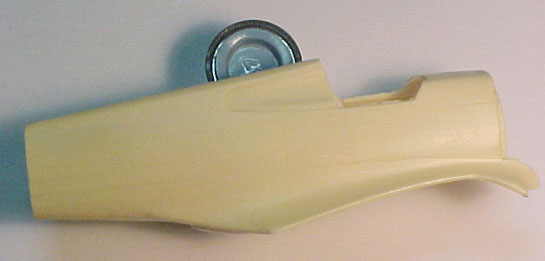
Fuselage
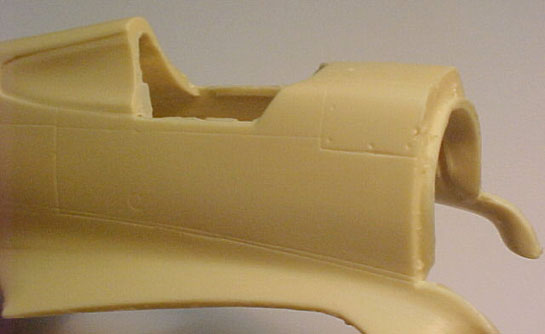
Detail shot of the fuselage area - Front cockpit and wing root

Detail shot of the fuselage area - Rear cockpit

Detail shot of the fuselage area - Inside cockpit area
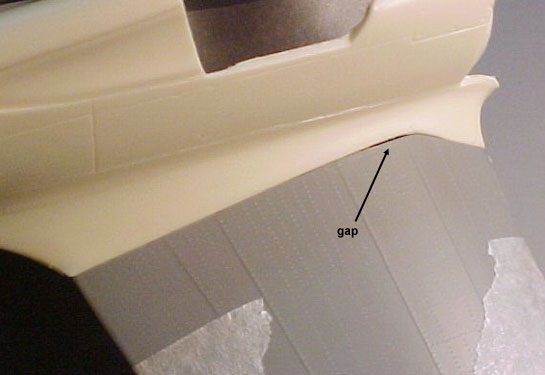
Wing root to fuselage joint
As for the accuracy, the lines of the P-40B/C rear fuselage are the same of the P-40D/E, except for the cockpit area, and the shape/dimensions are very well captured there (I've used the drawings from the Detail & Scale book, by Bert Kinzey). The recessed areas of the rear windows are also correct, but there is no representation of the fuel filler caps. These are very noticeable on the actual aircraft. The first aid/radio compartment door on the port side is there, but you should consider deepening it a bit with a gentle rescribing for good effect. Some panel lines are missing and you can scribe them very easily provided you have good drawings. One of the hardest part of this review was to find reliable scale drawings for the subject...and I'll tell you, they are not many...
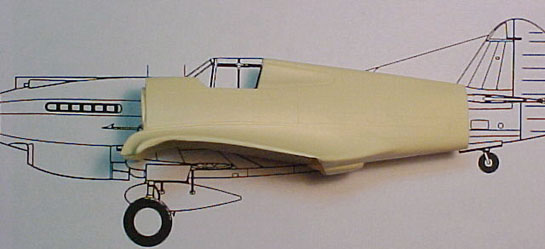
Checking fuselage accuracy
The blue position light just above the wing fairing is represented as a recessed circle, although not all early P-40s had it - check references for the bird you are going to model. The photo below shows the AVG veteran Erik Shilling in the cockpit of a fully restored P-40B adorned with his markings.

AVG veteran Erik shilling remembering old times onboard a restored Curtiss H81-A2 (photo:unknown)
NOSE
The nose is the most easy recognition point of the P-40B/C. Scratchbuilders made a good job on the nose moldings, too.
For some reason, not all break lines coincide with the panel lines, but you can take advantage of this by not worrying in preserving the grooves. Just fill the joint completely and sand. All the fasteners are well represented in a countersunk fashion.

Nose
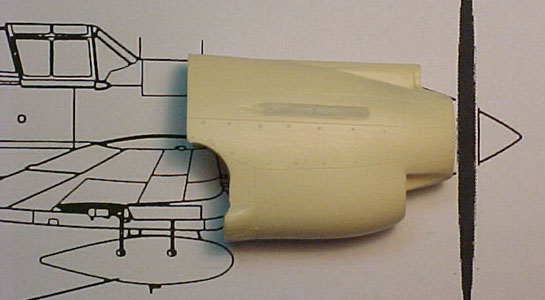
Checking nose accuracy
The circular carburetor air scoop even has a visible screen inside. The 0.50" machine guns fairing are well done and all you will need is to install the gun blast tubes made of plastic tubing a few scale inches out. There is a very thin resin skin over the stacks opening. Remove it and sand smooth to accept the exhaust stacks. Turning the part upside down, we find a well molded chin scoop for the engine coolant and oil cooler (another characteristic of early P-40's). However, comparing it to drawings and photos, it seems that the chin is excessively deep (consequence of the bottom nose area being too flat). That is the only fault in shape I noted. Scratchbuilders included an air duct to be installed from the inside, replacing Revell's part #11. Stick with Scratchbuilders' instructions during this step. The air duct encloses the oil cooler opening but not the radiator cooler ones. I guess that a thin curved plastic card can do the job. We included a picture of the P-40C on loan to the National Museum of Naval Aviation in Pensacola, FL (USA), showing the arrangement when viewed from the front - see below.
The Revell engine is to be used replacing the crankcase with the resin one. This is enough to account for the visual differences between the Allison V1710-33 of the P-40B/C and the V1710-39 of the P-40D/E. No removable access panels here so you may be wondering why to use the Revell engine. I suspect that this is to eliminate the see-through effect when looking from the engine air intake or cooling flaps. Also, it helps to align the crankcase shaft onto which the propeller will be inserted. The Revell engine is then aligned by the crankcase and the exhaust collars, so it won't be loose inside the cowling.
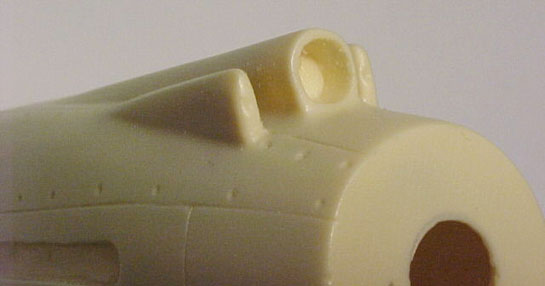
Detail shot of the nose - Carburetor air scoop and 0.50" MG fairing
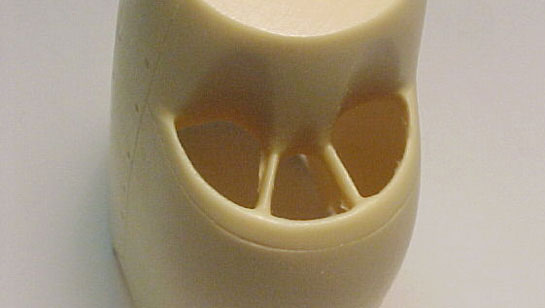
Detail shot of the nose - Radiators chin scoop. Compare to the photo below to see that the openings are too high
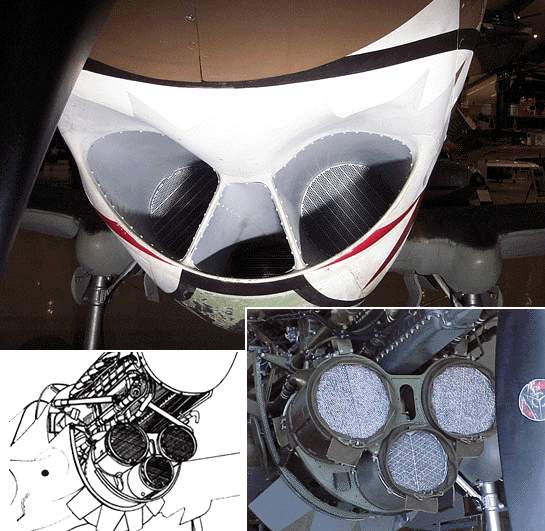
NMNA P-40C - Front view of the radiators chin scoop. Courtesy of Scott Murphy
In the detail, the arrangement of the coolers from the P-40N under restoration at Week's Air Museum (photo: unknown)
Moving aft, we have the major point of deception of the kit, in my opinion. The engine cooling flaps. After the "Pilot's Flight Operating Instructions" (see references) the pilot must open these shutters during the landing, and no mention is made to close them after the engine shutdown. That's why so many wartime photos show them open. Our problem is that this is a huge opening... you can see the radiators backside, lots of plumbing and even the engine block from there, as shown in the NMNA P-40C photo below. In short, the area is screaming for detail if you want so. Unfortunately the Scratchbuilders representation of the cooling flaps is very crude. I would recommend you to cut off the flaps from the nose and scratchbuilt new ones. Any attempt will give better looking results than the kit part. Another option is to use the Eduard's detailing set for the Revell P-40E, which comes with photoetched flaps:
- Eduard Accessories - Product #32017 P-40E Warhawk (for Revell kit).
A hint of the contents of this set can be found at ARC's instructions sheet library.

Detail shot of the nose - Radiator flaps
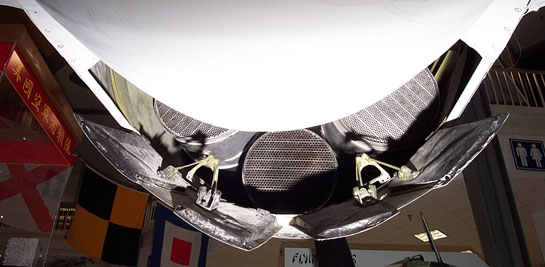
NMNA P-40C - Aft view of the radiators shutters. Courtesy of Scott Murphy
The other parts to be used here are the reshaped resin spinner and its back plate. They will be installed along with the Revell propeller later in the assembly. The white metal exhaust stacks are very crude and most of you probably won't like it. The kit instructions claim that you can use the later exhaust style which comes with the Revell kit, but assert this with your references because only the a few P-40C's used it.
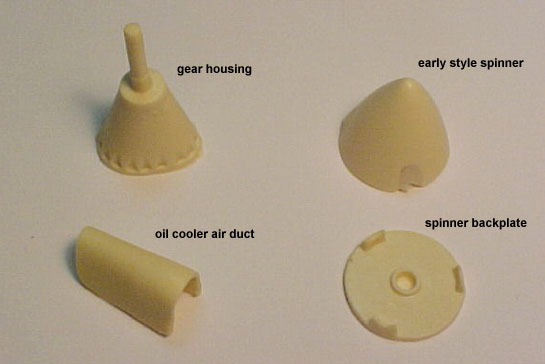
Other parts for the nose area
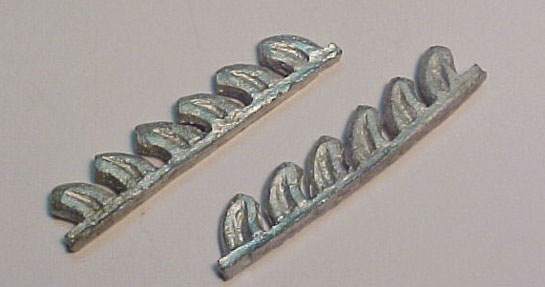
The white metal early style exhaust stacks
Now that we are talking about the propeller, it is worth it to note that many early WWII American aircraft had the propellers painted in black on the back face of the blades only. The front faces were generally left in natural metal. Seems insignificant, but this will determine the color of the propeller stencils to be applied. Most stateside early P-40s used that scheme as a factory finish. The black was not applied on the entire blade, but some inches from the blade root outwards, as shown in many photos. On the other hand, it doesn't seem to be the case of British Tomahawks and, in addition, there was field repainting, propeller substitution for newer parts etc. The USN photo below shows a typical P-40C in factory standard, while the AVG picture illustrates many interesting details found in a front line machine.
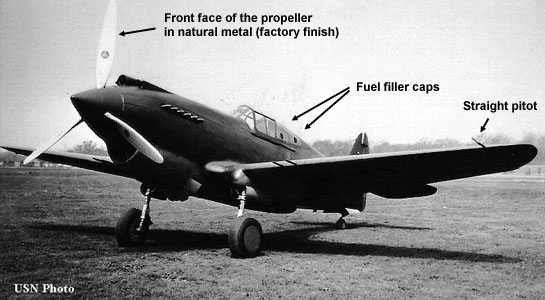
A factory fresh P-40C (photo: National Archives)

A Flying Tiger wartime photo showing many interesting details (photo: unknown)
COCKPIT
The cockpit is basically an adaptation of the Revell cockpit. For the detailers this sounds like a too simplistic solution, because the cockpits of B/C models had visible differences from the one of the E model. A new resin bulkhead is provided to match the resin fuselage, and the fit is good enough (clean it carefully). The characteristic "inverted T" control panel is also given. You have to cut the printed B & W control panel provided and glue it on the resin part. This is a questionable approach for an open canopy. A simple solution is to cut a thin plastic card using the resin control panel as a guide and punch out the holes for the dials. Paint this new front black and glue it on top of the printed panel. There is no representation of the aft ends of the two machine guns mounted in the cowling. Find something in your spare parts box...
The major problems of the cockpit are the Revell parts themselves, since the conversion uses most of them, and they are very crude. The sidewalls, seat, pedals, floor...everything is typical of a late 60's vintage kit: the floor is flat and should be curved (the cockpit floor of the P-40 was the wing upper surface), the seat is useless and the sidewalls are wrong even for the E-model.. Jerry Rutman's detail parts are handy here. Although they are intended for the dash-E, some parts can be used/adapted for a dash-B/C. Check it out in a full review by Brett Green, from Hyperscale. The seat for the B/C model was the same that the one in the E-model, but verify your references about the slight differences in the sidewall consoles. Also, many PE parts of the Eduard set cited above can be used.
Well, if you are thinking of a detailed model, you have to do something here. Besides the control panel, you will need at least a more convincing seat as well as sidewalls with the proper modifications. I'll leave you with some pics of the NMNA P-40C cockpit in case you need a starting point. I also scanned a few pertinent details from the "Pilot's Flight Operating Instructions".
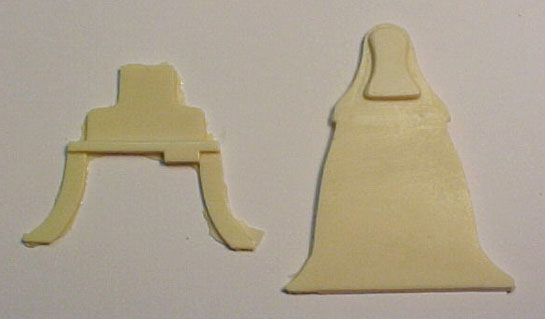
Resin control panel and bulkhead
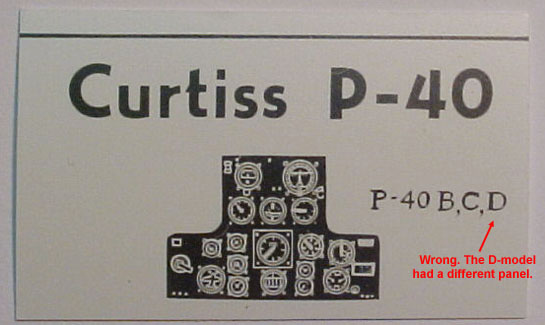
The printed control panel
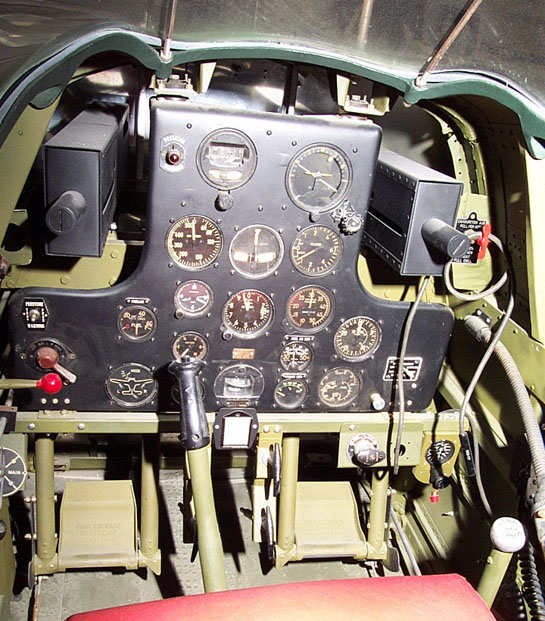
Control panel of the NMNA P-40C. Courtesy of Scott Murphy

Left sidewall of the NMNA P-40C. Courtesy of Scott Murphy
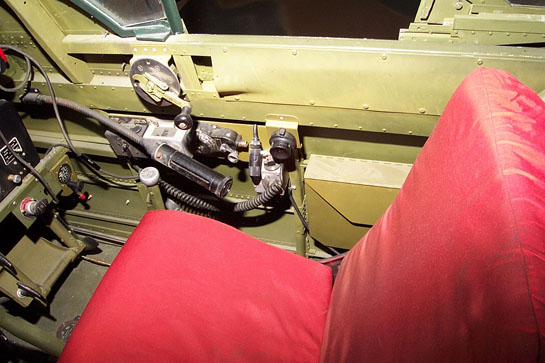
Right sidewall of the NMNA P-40C. Courtesy of Scott Murphy

Some cockpit details from the "Pilot's Flight Operating Instructions"
GUNS
One of the high points of the conversion, the wing mounted gun muzzles are provided as white metal parts and they are exquisitely molded. Take care during handling/cleaning because the metal is quite soft, some of them were bent in my sample. Just roll each one on a flat smooth surface to make them straight.
The instructions sheet include a 1/32 drawing of the bottom wings showing the correct positions of the wing guns and the spent casing chutes, a bit crude but correct. This drawing makes the task much easier in case you don't have your own plans in 1/32 scale (the P-40B/C had two 0.30" guns per wing, instead of the three 0.50" found in later versions).
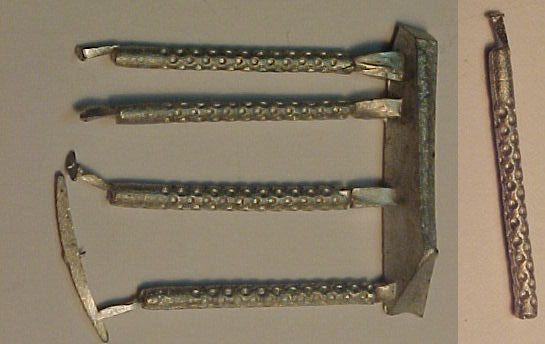
The white metal wing mounted gun muzzles
LANDING GEAR
The white metal main landing gear legs are one of the poorest parts of the conversion. The instructions claim that they have the correct length. This is because the Revell landing gear is designed to be retracted. Had the legs had the correct dimension the wheels wouldn't fit into the wells. However, the white metal legs provided are just lengthened metal copies of the Revell parts. Considering the somewhat crude casting of our sample, it seems better to lengthen the Revell legs.
The actual P-40 landing gear was an engineer's dream, full of mechanisms and hinges to rotate the wheels in order to fit them into the bays. An expert modeler will test his skills to scratchbuild a landing gear of that complexity, as Revell representation is very symbolic. Even the doors lack the proper details. Again, the J Rutman accessories set will save a lot of time here, as it comes with a complete new landing gear - including the wheel bays - to fit inside the Revell wing. Our friends from LSP staff reported that the set fits very well.
I included one more picture of the P-40C at NMNA along with some drawings to help on this area. If you are going to the make your own details, you can save some work by depicting a canvas covered wheel bay and a tail wheel with canvas boot. The canvas was factory standard to avoid dirt and dust entering the wing, but they were prone to tearing under heavy use, so that they were generally removed by the crewman.
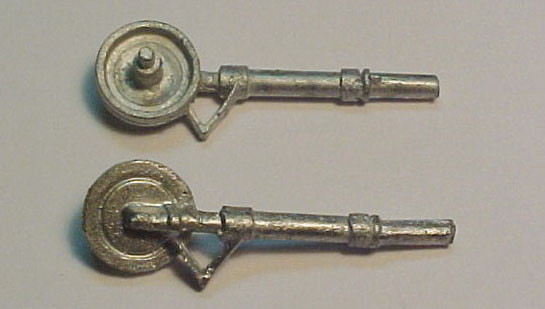
Main landing gear white metal parts
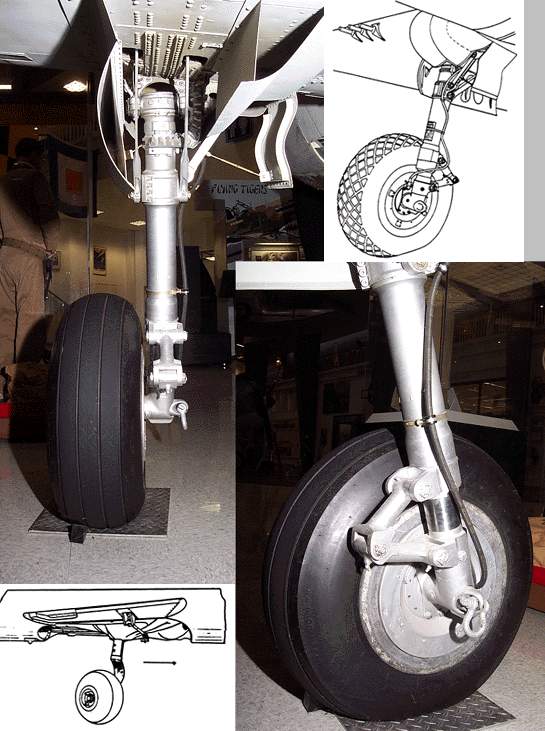
The main wheels retraction mechanism and strut of the NMNA P-40C. Courtesy of Scott Murphy
CLEAR PARTS
There are 3 vacuum formed clear parts for the canopy, incorporating a bit overdone frame lines. The rear windows are not flat, but curved - as they should be - following the fuselage cross section. All parts are very translucent and made of a material called Zivac. The instructions claim that bonding agents like Tenax-7R will work with that material. I tested Tenax-7R in a previously trimmed test stripe and it actually reacted with the material. On the other hand, Humbrol and Testors liquid cements didn't even stain the sample. Be warned then...
The sliding part comes attached to the windscreen, a careful trimming will be necessary to pose it open. Even if you are not going to cut them apart, I recommend you to turn the part up side down and then pour some plaster until the cavity is filled. Wait the plaster dry and trim the borders. This will give you a more stiff surface to run the knife. Once done, pop the plaster block out of the clear part and rinse with water.

The clear parts
DECALS
Two versions can be made out of the decal sheet:
- Curtiss H81-A2 s/n P-8173 flown by the AVG ace R. T. Smith. This is the famous #77 seen in many AVG wartime photos.
- Curtiss Tomahawk AK498 flown by the 250 Sq. ace Clive "Killer" Caldwell during the Africa campaign.
There are many important notes about the correct use the markings. Read the instructions carefully. For instance, the Disney's Flying Tiger is included in the sheet, but it was not used on #77. A nice touch is the pair of Chinese roundels to be used on top of the wings, which are printed in a slightly toned down blue to simulate fading (always more aggressive on top surfaces). You must follow Revell instructions for the stencil locations, although the numbers don't match (this is clearly noted in the instructions too).
As for the quality of the decals, they are very good, but my sample had the red layer out of register. This is not noticeable except for the red circles inside the eyes above the shark mouth. It didn't pass by Scratchbuilders quality control because they kindly provided a separated pair of eyes to replace those defective.
The decals are produced by Scale Master with the popular Invisa Clear system. If properly applied, I don't believe they will reject any setting solution or present silvering problems.
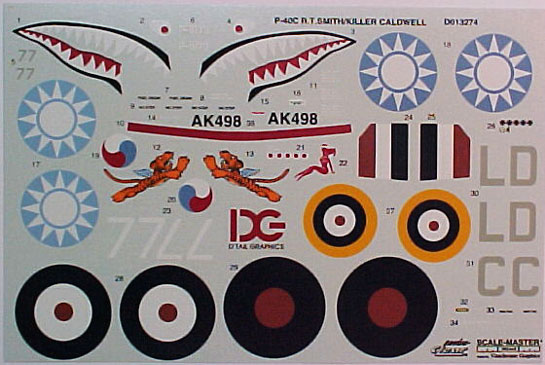
The decal sheet
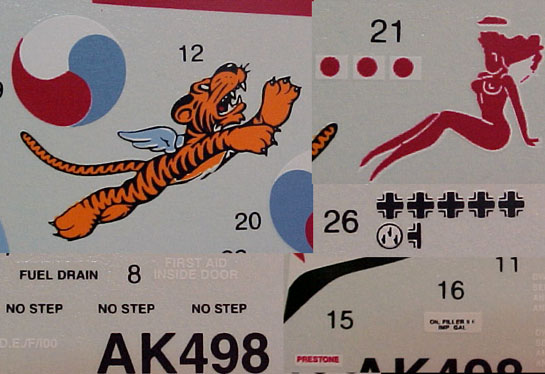
A zoom on the decal sheet details
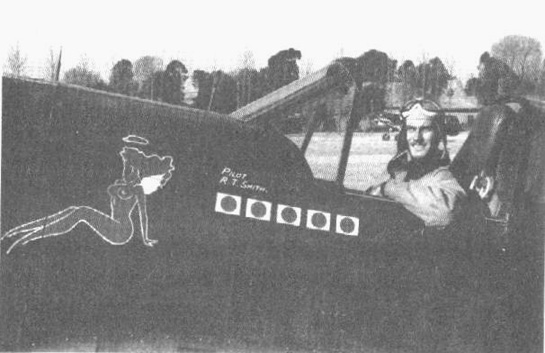
AVG ace R. T. Smith showing his five kills tally. Rangoon, Burma, late 1941
FINAL COMMENTS
Many modelers claim that the real Flying Tiger was the P-40B/C. Personal tastes apart, you won't have many choices to make an early hawk in 1/32. And there are many options to choose from for this conversion. If you don't want to stick with the R. T. Smith bird, you can choose one among the AVG famous pilots: Dick Rossi, Charlie Bond, "Tex"Hill, Charles Older, Erik Shilling and even Gregory "Pappy"Boyington. Although the Disney's Flying Tiger is provided in the decal sheet, most AVG P-40s used to wear some sort of artwork. This can be a problem unless you choose a machine from the first days of the group (initially AVG squadrons flew plain H81-A2 with just the fuselage numerals ad no elaborate artwork). Whatever the case, remember that the AVG machines were Curtiss Hawk H81-A2 (similar to the P-40C) which had been built for export to Britain. As a consequence the pitot tube must be of the cranked type and the factory applied colors didn't match perfectly the usual RAF Dark Green/Dark Earth/Sky cammo. Reportedly, Curtiss used DuPont Dark Green 71-013 and Dark Earth 71-009 for upper surfaces and possibly Light Gray 71-021 for undersurfaces. The question about the best FS matches of these colors is still open and you are on your own here. Moreover, AVG aircraft were generally heavily weathered, given the nasty conditions they operated (see photo below). All I can suggest you is to read the good discussion on the subject in Bridgewater's recent book (see references). If you are going to a British Tomahawk, the same comments apply. As usual with limited run kits, you won't find aftermarket decals for this bird (that I'm aware of).
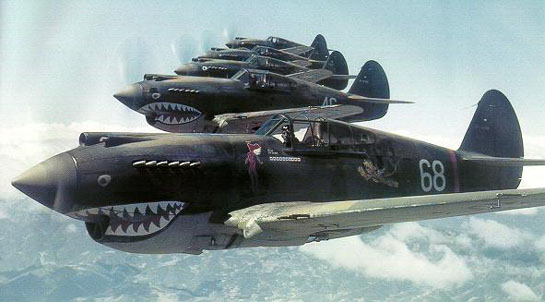
A widely published color photo of AVG flying formation
A good notice is that the conversion can be used to make a P-40-CU - the very initial version with lighter armament or finish it as a pre-war stateside P-40B. Ok, they were just olive drab 41 and gray, but I think what will make such a model different is the version. After all, an aviation aficionado will promptly note the differences from the original Revell kit.
Other interesting possibilities are those "Pearl Harbor defenders" stationed at Bellows and Nichols fields during the attack (some of them actually engaged the Japanese and downed a few) or the desperate fighters of the 20th Pursuit Squadron at Clark Field, Philippines during the first days of the war. Now if you want something very unusual, there was the P-40B used by the Russians.
Turning back to the conversion, I think that the only problem with it is the Revell kit itself. I didn't covere here all the work you have to do with the cockpit, landing gear, wings and tail to leave the Revell parts accurate because this will be addressed in another review. I'm not saying it is a bad kit, but it includes some toy like features which result in serious inaccuracies. The Scratchbuilders bits will do their part. I can anticipate, however, that the raised panel lines in the Revell parts are not consistent with the recessed ones in the resin fuselage and nose.
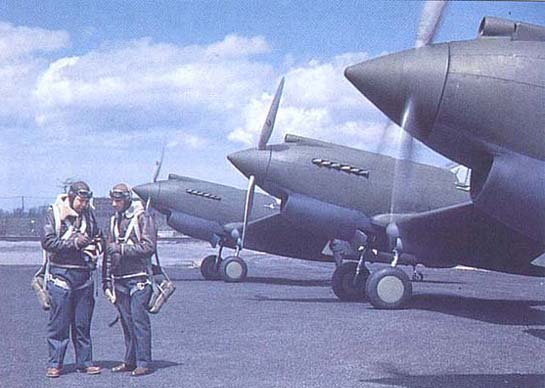
Curtiss test pilots Herb Fisher (left) and Ed Elliot prior to test flying several brand new P-40B fighters (none have guns installed)
Other important details are the pitot tube, which must be cranked for British and AVG machines (the boxtop artwork is wrong on this) and straight for the American ones. Also, there's no gun sight ring or mast, but they can be stolen from many photoetched sets. Don't forget to install these items in offset with the fuselage center line.
My references for this review were:
- McDowell, E. R.: Curtiss P-40 in Action, Squadron Signal Publ., 1976.
- Kinzey, B.: P-40 Warhawk in Detail - Part 1: YP-36 through P-40C, Detail & Scale Vol.61, Squadron Signal Publ., 1999.
- Kinzey, B.: P-40 Warhawk in Detail - Part 2: P-40D through XP-40Q, Detail & Scale Vol.62, Squadron Signal Publ., 1999.
- Drendel, L.: P-40 Warhawk Walk Around, Walk Around Number 8, Squadron Signal Publ., 1996.
- Famous Airplanes of the World, No. 39: Curtiss P-40 Warhawk, Burindo, 1993.
- Bridgewater, H. C.: The Curtiss P-36 and P-40 in USAAC/USAAF Service - 1939 to 1945, Combat Colours Number 3, Guideline Publ., 2001.
- Bridgewater, H. C. and Scott, P.: Pearl Harbor and Beyond - December 1941 to May 1942, Combat Colours Number 4, Guideline Publ., 2001.
- Technical Order No. 01-25CF-1: Pilot's Flight Operating Instructions - P-40D and P-40E Airplanes, AAF Headquarters, Air Service Command, Patterson Field, Fairfield OH, Feb 1943.
- P-40 Fighter Manual, AAF Headquarters, Office of Flying Safety, 1943.
The last two are more difficult to obtain but the others are easily found.
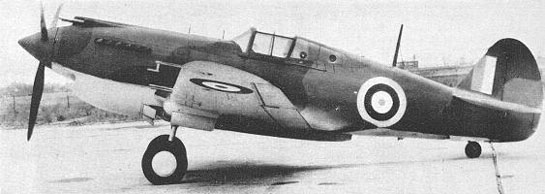
The Tomahawk as delivered by Curtiss to the RAF. Note the cranked pitot tube and the longer blast tubes
SUMMARY
As I mentioned, the major problem with this conversion is Revell kit. Had Scratchbuilders provided a complete cockpit I would rank it four stars - no doubt. For you early hawks fans the only other option is the Craftworks P-40C, but costs $125 USD!!!
This model is an excellent choice if you want to try a resin model in 1/32 for the first time. It is relatively easy to build and the finished product will fill a huge gap in any collection of American WWII aircraft.
By adding some details and correcting the most obvious Revell flaws, I'm convinced you will have a lot of fun and the result will be a truly unique model.

This is the result (Photo: Scratchbuilders)
ACKNOWLEDGMENTS
We would like to thank the support Forrest Cox, owner of Scratchbuilders, for providing the review sample. Also, our "inspiring master" Scott Murphy for consenting the use of his NMNA P-40C walkaround photos.
© Rato Marczak
This review was published on Saturday, July 02 2011; Last modified on Wednesday, May 18 2016
